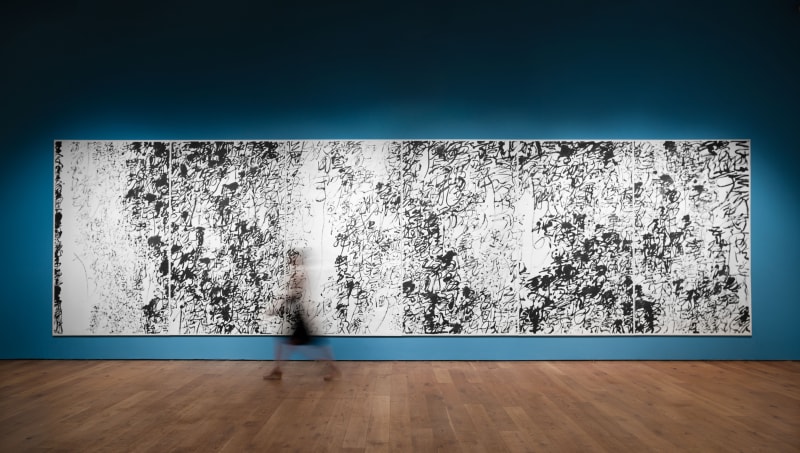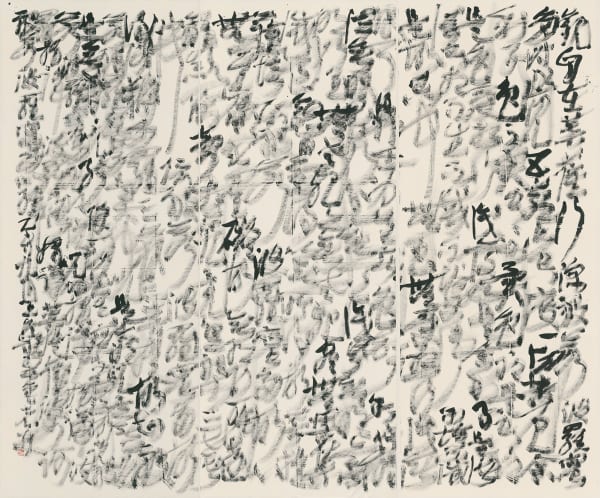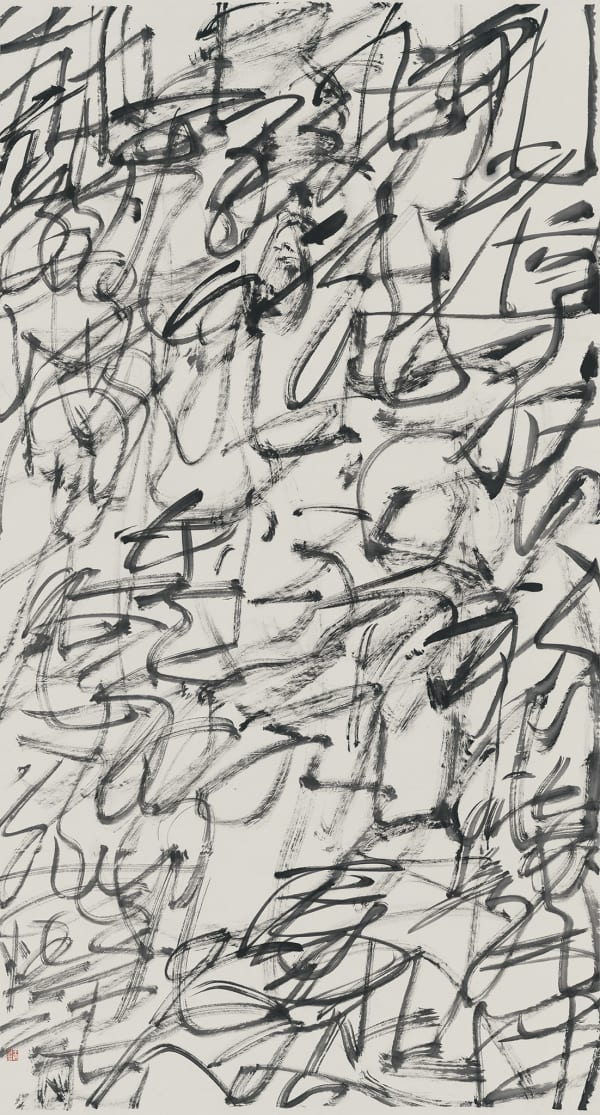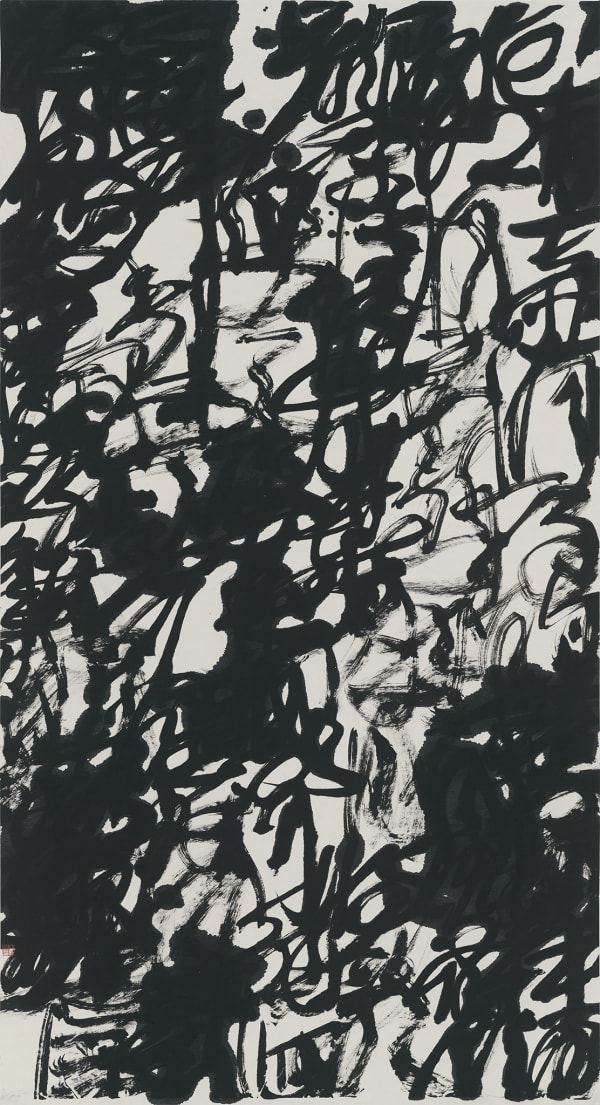Writing Chaos: Wang Dongling
Download the media packet.
INK studio is pleased to announce Writing Chaos, the first exhibition to unfold the full significance of Wang Dongling’s groundbreaking Chaos Script (luanshu). Wang Dongling is China’s most renowned calligrapher—the standard-bearer for an art form central to Chinese culture throughout history. Now, late in his career, he has introduced his most radical innovation: a new calligraphic script style that overturns the very foundations of the art. Curated by Dr. Britta Erickson, INK studio Artistic Director, the exhibition will open on September 17, 2016 and remain on view through November 20, 2016, complementing Wang's landmark solo exhibition in the Imperial Ancestral Temple of the Forbidden City (November 6-14, 2016).
Wang Dongling (b. 1945 in Jiangsu, China) has the unique status of being both a consummate traditional calligrapher and an avant-garde experimentalist. He is the only artist to have been granted three solo shows at the National Art Museum of China. In a career spanning six decades, he has consistently redefined Chinese calligraphy through experimentations with scale, performance, and materiality. He is best known for his monumental public performances in "mad cursive" script in China and abroad. He also has developed an ever-evolving parallel practice in gestural abstractions and works on alternative media, catalyzed by his exposure to postmodern Western art while living and teaching in the United States in 1989-1992.
Chaos Script is the culmination of Wang Dongling’s lifelong pursuit of an art that is at once universal and Chinese, forward-looking and firmly grounded in the past. In a move unprecedented in history, Wang Dongling breaks away completely from the implied grid of traditional calligraphy, interweaving individual characters and entire columns into an amorphous field. As the text verges on illegibility, its linguistic meaning becomes an open question. The calligraphic lines take flight in their variations in texture and rhythm, and yet remain tenuously tethered to the text as musical performance is to score and meter. The chaos is in fact controlled chaos, its freedoms honed by a lifetime of daily discipline: the construction of Wang Dongling's every character still satisfies the desiderata of classical calligraphy.
At once transgression and transcendence, negation and renewal, Chaos Script fulfills the incomplete radical experiments of past masters like Xu Wei (1521-1593) and Huang Binhong (1865-1955)—the latter Wang Dongling's teacher's teacher. Here the tension between reading and seeing becomes a universal ground for aesthetic experience: whether literate in Chinese or knowledgeable in the classical texts that Wang writes, the viewer is compelled to experience them afresh. Chaos Script restores culture to a state of primal nature. The poetics of navigating it—being by turns absorbed, alienated, and set adrift—becomes a metaphor for the process of defining for ourselves the meaning of classical Chinese culture in the digitalized, globalized present. It is appropriate that an inspiration of Chaos Script is the tangled stems of wilted lotuses on the West Lake of his adopted home of Hangzhou, an image for him of impending vitality within dissolution.
Writing Chaos presents a careful selection of works ranging in medium, scale, and effect. Among the highlights are Wang Dongling's tour-de-force room-sized renditions of The Thousand Character Classic (2014), a canonical calligraphic text in which no character is repeated, and the Heart Sutra (2015), a foundational scripture of Mahayana Buddhism. These monumental works' symphonic quality is revealed in their scale and pace, and in the waxing and waning of tonality. The Heart Sutra is accompanied by a video of its live performance at the Brooklyn Museum in November 2015. Also on view are medium- and small-scale works that rehearse sensual and erotically-charged poems of the Tang and Song dynasties, some on the non-traditional media of canvas and watercolor paper.
Committed to being the premier venue for major presentations of Wang Dongling's innovations, INK studio cosponsored his Brooklyn Museum performance and is preparing a bilingual academic monograph on his work. Writing Chaos follows Wang Dongling's widely acclaimed solo exhibition at INK studio, The Origins of Abstraction (winter 2013-4), which showcased his abstract paintings and calligraphic abstractions. The present exhibition celebrates Wang Dongling's unique position as an artist who, with understated daring and a natural ease, has forged a path for calligraphy towards the future and the world.
-
 Wang Dongling 王冬龄, The Heart Sutra 心经, 2015
Wang Dongling 王冬龄, The Heart Sutra 心经, 2015 -
 Wang Dongling 王冬龄, The Qian Hexagram from the Book of Changes 易经·乾, 2016
Wang Dongling 王冬龄, The Qian Hexagram from the Book of Changes 易经·乾, 2016 -
 Wang Dongling 王冬龄, Li Bai, "Drinking Alone in Moonlight: Verse One" 李白 月下独酌四首·其一, 2016
Wang Dongling 王冬龄, Li Bai, "Drinking Alone in Moonlight: Verse One" 李白 月下独酌四首·其一, 2016 -
 Wang Dongling 王冬龄, Huang Tingjian, "The Modest Garden Cannot Expect Clouds and Rain," to the Tune of Dingfengbo 黄庭坚 定风波·小院难图云雨期, 2016
Wang Dongling 王冬龄, Huang Tingjian, "The Modest Garden Cannot Expect Clouds and Rain," to the Tune of Dingfengbo 黄庭坚 定风波·小院难图云雨期, 2016 -
 Wang Dongling 王冬龄, The Thousand Character Classic 千字文, 2014
Wang Dongling 王冬龄, The Thousand Character Classic 千字文, 2014 -
 Wang Dongling 王冬龄, Fluttering Flowers, Scattered Snow飞花散雪, 2015
Wang Dongling 王冬龄, Fluttering Flowers, Scattered Snow飞花散雪, 2015 -
 Wang Dongling 王冬龄, Bai Juyi, Sequel to the "Inscriptions on my Right" 白居易 续座右铭, 2016
Wang Dongling 王冬龄, Bai Juyi, Sequel to the "Inscriptions on my Right" 白居易 续座右铭, 2016 -
 Wang Dongling 王冬龄, Huang Tingjian, "The Modest Garden Cannot Expect Clouds and Rain," to the Tune of Dingfengbo 黄庭坚 定风波·小院难图云雨期, 2016
Wang Dongling 王冬龄, Huang Tingjian, "The Modest Garden Cannot Expect Clouds and Rain," to the Tune of Dingfengbo 黄庭坚 定风波·小院难图云雨期, 2016 -
 Wang Dongling 王冬龄, Li Bai, "Drinking Alone in Moonlight: Verse One" 李白 月小独酌四首·其一, 2016
Wang Dongling 王冬龄, Li Bai, "Drinking Alone in Moonlight: Verse One" 李白 月小独酌四首·其一, 2016 -
 Wang Dongling 王冬龄, Li Bai, "In the Qingping Mode" (First Verse) 李白 清平调·其一, 2016
Wang Dongling 王冬龄, Li Bai, "In the Qingping Mode" (First Verse) 李白 清平调·其一, 2016 -
 Wang Dongling 王冬龄, Su Shi, "Inscription on the Wall of the Xilin Monastery" 苏轼 题西林壁, 2016
Wang Dongling 王冬龄, Su Shi, "Inscription on the Wall of the Xilin Monastery" 苏轼 题西林壁, 2016 -
 Wang Dongling 王冬龄, Su Shi, "Fallen Petals Have Danced the Dance of Wind," to the Tune of Yumeiren 苏轼 虞美人·落花已作风前舞, 2016
Wang Dongling 王冬龄, Su Shi, "Fallen Petals Have Danced the Dance of Wind," to the Tune of Yumeiren 苏轼 虞美人·落花已作风前舞, 2016 -
 Wang Dongling 王冬龄, Zhang Ruoxu, "Flowers and Moon by the River on a Spring Night" 张若虚 春江花月夜, 2016
Wang Dongling 王冬龄, Zhang Ruoxu, "Flowers and Moon by the River on a Spring Night" 张若虚 春江花月夜, 2016


















